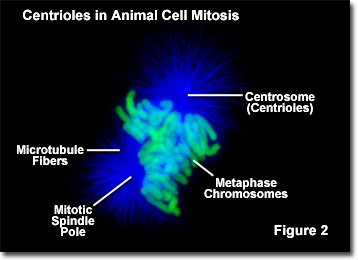Do Both Animal And Plant Cells Have Centrioles
Centrioles
Found only in animal cells, these paired organelles are typically located together nearly the nucleus in the centrosome, a granular mass that serves as an organizing center for microtubules. Inside the centrosome, the centrioles are positioned so that they are at correct angles to each other, as illustrated in Effigy 1. Each centriole is made of 9 bundles of microtubules (three per bundle) bundled in a ring.

Centrioles play a notable role in cell division. During interphase of an animal cell, the centrioles and other components of the centrosome are duplicated, though scientists are not yet certain how this duplication takes identify. At starting time the two pairs of centrioles remain in close proximity to each other, only as mitosis initiates, the original centrosome divides and the pairs are split up so that one set up of centrioles is located in each of the new microtubule-organizing centers. These new centers radiate microtubules in star-shaped clusters known every bit asters. As the asters move to opposing poles of the cells, the microtubules, with the assistance of the centrioles, get organized into a spindle-shaped formation that spans the cell (see Figure 2). These spindle fibers human action as guides for the alignment of the chromosomes every bit they split later during the process of cell division.
Though centrioles play a office in the mitosis of beast cells, plant cells are able to reproduce without them. Researchers have, therefore, been very interested in determining exactly how important the organelles actually are. Studies have shown that sure animal cells, particularly female gametes (oocytes), tin successfully separate even when their centrioles are destroyed. Some investigators accept also found, however, that the absence of centrioles in animal cells is associated with an increased number of bounded errors and substantial delays in the mitotic procedure, especially before chromosome segregation. Consequently, it has been suggested that centrioles evolved as a refinement of the cell, making mitosis a much more efficient and less error-prone process.

In cells that characteristic cilia or flagella, basal bodies, which exhibit the aforementioned structural form equally centrioles, are nowadays. These assemblies are located, however, near the cell surface at the base of each cilium or flagellum, rather than in the centrosome nearly the nucleus. Basal bodies are anchored in their cytoplasmic locations by what is chosen a rootlet system in the cell. In some organisms, such as the unicellular Chlamydomonas , basal bodies change their location and are functionally converted to centrioles before the mitotic process.
BACK TO ANIMAL Cell STRUCTURE
Questions or comments? Ship us an email.
© 1995-2022 by Michael W. Davidson and The Florida Land Academy. All Rights Reserved. No images, graphics, software, scripts, or applets may exist reproduced or used in any manner without permission from the copyright holders. Use of this website means you agree to all of the Legal Terms and Weather condition set forth by the owners.
This website is maintained by our
Graphics & Spider web Programming Team
in collaboration with Optical Microscopy at the
National Loftier Magnetic Field Laboratory.
Last modification: Friday, Nov 13, 2015 at 02:18 PM
Admission Count Since October 1, 2000: 538034
Microscopes provided by:
Source: https://micro.magnet.fsu.edu/cells/centrioles/centrioles.html
Posted by: carmonaoffirest1957.blogspot.com

0 Response to "Do Both Animal And Plant Cells Have Centrioles"
Post a Comment